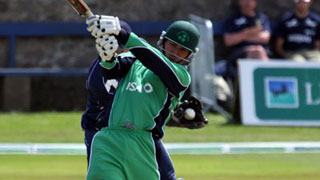Slow powerplay batting approach, designed to mitigate against collapses, fails to do so yet again
Ireland are not unfamiliar with batting collapses. Against Pakistan today, they lost seven wickets for just 66 runs to stumble to defeat. Given the context, an eminently winnable World Cup qualifier, this was the most galling example of snatching defeat from the jaws of victory in recent memory.
Gaby Lewis (44), Amy Hunter (44) and Orla Prendergast (37) all got starts. Yet dot balls were never far from Ireland’s innings, the low total not sufficiently eaten into by the time a weaker middle order was asked to steer things home. Not that those lower in the order are blameless, some of the shot selection illustrating either pressure or a lack of thinking - perhaps both.

Ireland should have comfortably chased 218 on this surface. Yet they continued to bat in the turgid style which has plagued them of late in 50-over cricket. 60 legal deliveries were bowled in the powerplay today. 44 of these were dots. The first 10 overs are supposed to be the best time to bat with the field up and the new ball coming on nicely.
This approach, featuring a baffling lack of intent, has been a consistent feature. Since the 2024 home summer, they’ve now played 15 ODIs. In 12 of those, they’ve faced at least 40 dot balls in the 60-ball powerplay. It’s a staggering lack of scoring.
Of the three occasions when they had fewer than 40 dots, one was against Thailand in a jeopardy-free warm-up for these qualifiers. The other came versus England in a rain-shortened game.
Speaking prior to the England series last year, head coach Ed Joyce expressed his satisfaction with Ireland’s decreasing dot ball percentage. One assumes he was referencing the middle overs period, with the likes of Orla Prendergast and Leah Paul having success when Sri Lanka were in town. Ireland haven’t consistently scored powerplay runs in some time.
The trend has gone on so long that it can only be a clear tactic, a directive from either the coaching staff or senior players. It certainly is not an issue with talent, given we have seen the likes of Lewis and Hunter play more positively in T20 cricket.
Perhaps the thinking concerns ability elsewhere in the line-up. Maybe Ireland have acknowledged they don’t have enough batters with the requisite skill and experience to take them to decent totals. Therefore senior players need to face the majority of deliveries, diminishing their desire to take risks. But there’s minimising risk and there’s facing 44 dot balls at the start of the innings. A middle ground does exist.
If Lewis, Hunter or Prendergast had batted the entirety of this innings and won the game, they would be labelled sensible. We would be hailing a mature innings. Who cares if it was an ugly spectacle? Those without skin in the game would not have been likely to watch, but does that matter in a do-or-die qualifier?
The flip side is, though, what happens if those players who chew up so many deliveries don’t get the job done? Opener Sarah Forbes faced 29 balls for just nine runs. Lewis got to 44 off 67. Hunter reached the same score but faced fewer deliveries - 54. When Hunter departed, Ireland were on 113-3. They lost their next seven wickets for just 66 runs. The middle order wilted under the pressure of requiring five runs an over for an extended period.
Dot balls atop the order is one thing, but the shot selection of those who sparked the collapse still deserves scrutiny. Laura Delany was bowled playing a paddle sweep when there was no pace on the ball. Leah Paul missed a reverse sweep. Prendergast yorked herself when coming down the track. Only Arlene Kelly really can say she got a good nut, Diana Baig nipping one back through the gate beautifully.
It’s a bit of a chicken and egg scenario. Does the Irish middle order play these shots because of the pressure built by slow scoring earlier in the innings, or do they not having stronger, safer shots down the ground in the locker? If the latter, then the safety-first approach of the top order is probably justified. But such an admission would be a significant indictment of the batting talent in this line-up.
If that is the case, then Ireland need to just keep on plowing on. Keep telling the better players to bat within themselves and hope they win you enough matches. On the evidence of today, they won’t do so often enough to qualify. They certainly won’t score enough runs against a West Indies side featuring Hayley Matthews, provided her injury scare against Scotland today doesn’t lead to a stint on the sidelines.
This slow, uninspiring approach may well be a case of making the least bad decision when game planning to hide deficiencies. Even if there are merits to such tactics, 44 dots in the first 60 deliveries cannot be in the plan.
There is a gear between recklessly sweeping and blocking the living daylights out of it. Ireland need to find it. Stat.






